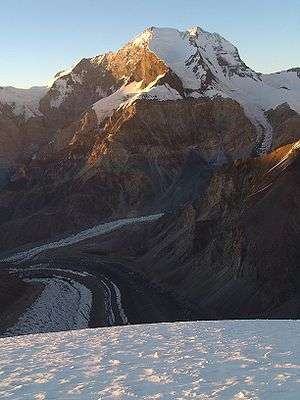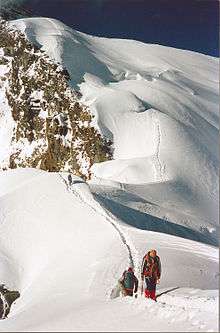Peak Korzhenevskaya
Korzhenevskoi Peak is the third highest peak in the Pamir Mountains of Tajikistan. It is one of the five "Snow Leopard Peaks" in the territory of the former Soviet Union. It is named after Evgenia Korzhenevskaya, the wife of Russian geographer Nikolai L. Korzhenevskiy, who discovered the peak in August 1910.
| Korzhenevskoi Peak | |
|---|---|
| Пик Корженевской | |
 | |
| Highest point | |
| Elevation | 7,105 m (23,310 ft) [1] |
| Prominence | 1,650 m (5,410 ft) [1] |
| Isolation | 11.6 km (7.2 mi) |
| Listing | Ultra |
| Coordinates | 39°03′27″N 72°00′30″E [1] |
| Geography | |
 Korzhenevskaya Location in Tajikistan | |
| Location | GBAO, Tajikistan |
| Parent range | Academy of Sciences Range (Pamirs) |
| Climbing | |
| First ascent | 1953 by A. Ugarov et al. |
| Easiest route | rock/snow/ice climb |
Due to transliteration and declension issues the peak's name is rendered in many different ways, including Korzhenevski, Korzhenevskoi, and Korzhenievsky.
Location
Peak Korzhenevskaya lies about 13 km (8.1 mi) north of Ismoil Somoni Peak (formerly Communism Peak), the highest point of the Pamirs. It forms the end of the northwest fork of the Academy of Sciences Range, the north-south trending subrange which forms the core of the Pamirs. It rises on the south bank of the Muksu River, and to the west of the peak is the Fortambek Glacier. While most of the Academy of Sciences Range is in Tajikistan's Gorno-Badakhshan Autonomous Province (GBAO), Korzhenevskoi is located a little to the west of the GBAO line, in Jirgatol district (Region of Republican Subordination).
Notable features
Korzhenevskoi Peak is one of the five 7,000 m peaks of the former Soviet Union (this counts Khan Tengri, which is more often given as 6,995 m) that were required for a climber to be awarded the Snow Leopard award, the highest honor given to Soviet mountaineers. It is usually said to be the second easiest of these peaks to climb, after Lenin Peak. However it is not a small mountain; its rise above local terrain rivals that of Ismoil Somoni Peak, since it is closer to the deep valley of the Muksu River.
Climbing history

In 1937 D. Gushchin led an attempt on the peak which reached the lower summit (6,910 m).
Korzhenevskoi Peak was first climbed in 1953 by a party led by A. Ugarov; the summit team comprised Ugarov, B. Dimitriev, A. Goziev, A. Kovyrkov, L. Krasavin, E. Ryspajev, R. Sielidzanov, and P. Skorobogatov. They approached via the Fortambek Glacier, to the Korzhenevsky glacier, and thence to the north ridge.
Partly since it is required for the Snow Leopard award, Korzhenevskoi Peak has been climbed many times; it is the second most frequented major peak in the Pamirs, after Lenin Peak. A base camp on the moraine of the Moskvin Glacier, and helicopter access, make this possible. Korzhenevskoi Peak has been climbed from almost every direction, including a first winter ascent in 1987 by Anatoly Nosov; most of these ascents were by Russians. The most common current route on the mountain ascends from the south and attains the summit ridge from the west side.
References
- "The Central Asian Republics: Ultra-Prominence Page". Peaklist.org. Retrieved 2014-05-26.
Sources
- Jill Neate, High Asia: An Illustrated History of the 7000 Metre Peaks, ISBN 0-89886-238-8
- Robin Collomb and Andrew Wielochowski, Pamir-Trans Alai Mountains, 1:200,000 scale map and guide, West Col Productions.
- DEM files (Corrected versions of SRTM data)
- Vladimir Shataev, Snow Leopards